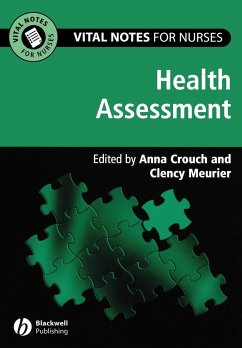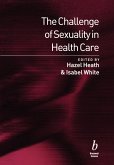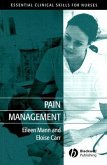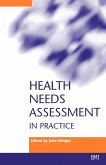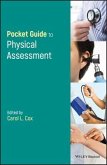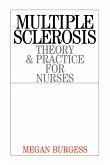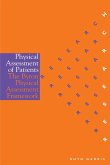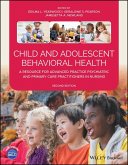- Broschiertes Buch
- Merkliste
- Auf die Merkliste
- Bewerten Bewerten
- Teilen
- Produkt teilen
- Produkterinnerung
- Produkterinnerung
Health assessment is central to effective planning, implementation and evaluation of nursing care. All nurses are accountable for the care they provide and need to be able to accurately determine patient needs in order to plan and deliver evidence-based care. Vital notes for nurses: Health assessment provides students with the knowledge required to consider the many different factors which can influence patient's health, comfort, well-being and recovery and to confidently assess patient needs. Vital notes for nurses: Health assessment explores concepts of holism, health and illness, factorsto…mehr
Andere Kunden interessierten sich auch für
![The Challenge of Sexuality in Health Care The Challenge of Sexuality in Health Care]() Hazel HeathThe Challenge of Sexuality in Health Care62,99 €
Hazel HeathThe Challenge of Sexuality in Health Care62,99 €![Pain Management Pain Management]() Eileen MannPain Management43,99 €
Eileen MannPain Management43,99 €![Health Needs Assessment in Practice Health Needs Assessment in Practice]() Health Needs Assessment in Practice64,99 €
Health Needs Assessment in Practice64,99 €![Pocket Guide to Physical Assessment Pocket Guide to Physical Assessment]() Pocket Guide to Physical Assessment42,99 €
Pocket Guide to Physical Assessment42,99 €![Multiple Sclerosis Multiple Sclerosis]() Megan BurgessMultiple Sclerosis86,99 €
Megan BurgessMultiple Sclerosis86,99 €![Physical Assessment of Patients Physical Assessment of Patients]() Ruth HarrisPhysical Assessment of Patients69,99 €
Ruth HarrisPhysical Assessment of Patients69,99 €![Child and Adolescent Behavioral Health Child and Adolescent Behavioral Health]() Child and Adolescent Behavioral Health112,99 €
Child and Adolescent Behavioral Health112,99 €-
-
-
Health assessment is central to effective planning, implementation and evaluation of nursing care. All nurses are accountable for the care they provide and need to be able to accurately determine patient needs in order to plan and deliver evidence-based care. Vital notes for nurses: Health assessment provides students with the knowledge required to consider the many different factors which can influence patient's health, comfort, well-being and recovery and to confidently assess patient needs. Vital notes for nurses: Health assessment explores concepts of holism, health and illness, factorsto consider when assessing patients, communication skills needed for assessment, and all aspects of holistic assessment including physical, psychological, social, cultural and spiritual factors and nutritional needs.
Hinweis: Dieser Artikel kann nur an eine deutsche Lieferadresse ausgeliefert werden.
Hinweis: Dieser Artikel kann nur an eine deutsche Lieferadresse ausgeliefert werden.
Produktdetails
- Produktdetails
- Verlag: Wiley
- Seitenzahl: 360
- Erscheinungstermin: 9. Dezember 2005
- Englisch
- Abmessung: 244mm x 170mm x 19mm
- Gewicht: 621g
- ISBN-13: 9781405114585
- ISBN-10: 1405114584
- Artikelnr.: 22712836
- Herstellerkennzeichnung
- Libri GmbH
- Europaallee 1
- 36244 Bad Hersfeld
- gpsr@libri.de
- Verlag: Wiley
- Seitenzahl: 360
- Erscheinungstermin: 9. Dezember 2005
- Englisch
- Abmessung: 244mm x 170mm x 19mm
- Gewicht: 621g
- ISBN-13: 9781405114585
- ISBN-10: 1405114584
- Artikelnr.: 22712836
- Herstellerkennzeichnung
- Libri GmbH
- Europaallee 1
- 36244 Bad Hersfeld
- gpsr@libri.de
Anna Crouch and Clency Meurier are both Senior Lecturers at University of Northampton.
Preface xi
Acknowledgements xii
Dedication xiv
List of contributors xv
1 The human body (C. Meurier) 1
Section 1: Introduction 1
Anatomical terms 2
Levels of organisation of the body 4
Hierarchy of functions 5
The basic structure of cells 5
Homeostasis 8
Organ systems 11
Section 2: The integumentary system 11
Structure of the skin 12
Thermoregulation and the skin 14
Section 3: The musculoskeletal system 14
The human skeleton 14
Bone 14
Joints 15
Muscular tissue 16
Section 4: The nervous system 17
Structure and function of the nervous system 17
The central nervous system 19
The autonomic nervous system 22
Sensations 23
Somatic senses 23
Pain 23
Section 5: The special senses 24
The eye 24
The ear 26
Section 6: The endocrine system 28
Hormones 28
Negative and positive feedback mechanisms 28
Section 7: The respiratory system 28
The mechanism of breathing 31
The transport of oxygen 32
The transport of carbon dioxide 33
Section 8: The cardiovascular system 33
The blood 33
The heart 34
Blood vessels: arteries, capillaries and veins 37
Section 9: The lymphatic and immune system 38
Components 38
Functions 38
Section 10: The digestive system 40
Functions 40
Organs of the digestive system and their location 40
Section 11: The urinary system 43
The kidney and its functions 44
Section 12: The reproductive system 46
Female reproductive system 47
The male reproductive organs 49
2 Nursing assessment and care planning (J. Aldridge, A. Eshun and C.
Meurier) 52
Introduction 52
Nursing assessment and the nursing process 53
Advantages of using a conceptual model in assessment 71
Key issues and developments 72
3 Concepts of health, illness and holism (C. Meurier) 76
Introduction 76
Being 'healthy' 77
Health beliefs and health behaviour 80
Illness, sickness and disease 82
Seeing the person as a whole 84
Assessment 87
4 Factors to consider when assessing patients (A. Crouch, G. Rumbold, M.
Thompson and W. Turner) 95
Section 1: Introduction 95
Ethical aspects of assessment 95
Respect for persons - definition 96
Privacy 98
Confidentiality 99
Respect for dignity 101
Truthfulness 102
Section 2: The environment, health status, age and cognitive ability of the
patient, learning disability and health assessment 103
Environment 104
Health status of the patient 105
The patient's age 106
Cognitive development and ability 108
The assessment of children 112
Section 3: Gender and health assessment 114
Trends and patterns of health and disease among men and women 115
Health issues and dilemmas for men and women 116
A health assessment approach: some practical aspects to consider 118
5 Communication skills for holistic health assessment (A. Crouch) 128
Introduction 128
Definition and classification 129
Factors that facilitate effective communication 131
Skills needed during holistic health assessment 132
Barriers to communication during holistic assessment 138
Record keeping 144
6 Physical assessment (C. Meurier, J. Brown and A. Crouch) 148
Section 1: Introduction 148
The purpose of physical assessment 150
Approach to physical assessment 150
Preparation for physical assessment 150
Techniques of physical assessment 151
The general survey and vital signs 154
Section 2: Physical assessment of the integumentary system 163
The skin 164
Assessment of nails 166
Assessment of hair 167
Section 3: Physical assessment of the respiratory system 168
Taking a health history 168
Physical examination 169
Section 4: Physical assessment of the cardiovascular system 171
Relevant health history 172
Risk factors for coronary heart disease 175
Physical examination 175
Section 5: Physical assessment of the nervous system 178
Relevant health history 178
Examination 178
Section 6: Physical assessment of the eyes, ears, nose and throat 187
The eyes 187
The ears 191
The mouth, nose, sinuses and throat 192
Section 7: Physical assessment of the digestive system 195
Relevant health history 196
Risk factors 196
Physical assessment 197
Section 8: Physical assessment of the urinary tract system 200
Assessment of the urinary system 201
Assessment of the prostate gland 204
Section 9: Physical assessment of the musculoskeletal system 205
The musculoskeletal system 205
Assessment 206
Section 10: Physical assessment of the female and male reproductive systems
210
Examination of the breast 210
Examination of the female genitalia 214
Assessment of the male reproductive system 224
Record keeping 228
7 Assessment of nutritional status (M. Ingham and J. O'Reilly) 234
Introduction 234
Purpose of nutritional assessment 235
Components of food 235
Nutritional requirements 245
Dietary guidelines 246
Assessing nutritional status 246
Dietary assessment 257
Nutritional interventions 259
8 Social assessment in healthcare (S. O'Brien) 264
Introduction 264
The purpose of social assessment 265
Health policy: assessing social needs 266
Nursing models, social influences and assessment 267
Nursing and interprofessional approaches to social assessment 268
The social assessment/analysis framework 271
The levels of social assessment 284
9 Psychological assessment (J. H. Parkes) 288
Introduction 288
What is psychological health? 289
Why conduct a psychological assessment? 290
What to assess 291
How to conduct the psychological assessment 299
Nurses' role in assessment 299
The assessment process 300
Accurate reporting and documentation 307
10 Cultural and spiritual health assessment (S. Allen and A. Crouch) 311
Cultural health assessment 311
Spirituality and spiritual needs 318
Glossary 331
Index 339
Acknowledgements xii
Dedication xiv
List of contributors xv
1 The human body (C. Meurier) 1
Section 1: Introduction 1
Anatomical terms 2
Levels of organisation of the body 4
Hierarchy of functions 5
The basic structure of cells 5
Homeostasis 8
Organ systems 11
Section 2: The integumentary system 11
Structure of the skin 12
Thermoregulation and the skin 14
Section 3: The musculoskeletal system 14
The human skeleton 14
Bone 14
Joints 15
Muscular tissue 16
Section 4: The nervous system 17
Structure and function of the nervous system 17
The central nervous system 19
The autonomic nervous system 22
Sensations 23
Somatic senses 23
Pain 23
Section 5: The special senses 24
The eye 24
The ear 26
Section 6: The endocrine system 28
Hormones 28
Negative and positive feedback mechanisms 28
Section 7: The respiratory system 28
The mechanism of breathing 31
The transport of oxygen 32
The transport of carbon dioxide 33
Section 8: The cardiovascular system 33
The blood 33
The heart 34
Blood vessels: arteries, capillaries and veins 37
Section 9: The lymphatic and immune system 38
Components 38
Functions 38
Section 10: The digestive system 40
Functions 40
Organs of the digestive system and their location 40
Section 11: The urinary system 43
The kidney and its functions 44
Section 12: The reproductive system 46
Female reproductive system 47
The male reproductive organs 49
2 Nursing assessment and care planning (J. Aldridge, A. Eshun and C.
Meurier) 52
Introduction 52
Nursing assessment and the nursing process 53
Advantages of using a conceptual model in assessment 71
Key issues and developments 72
3 Concepts of health, illness and holism (C. Meurier) 76
Introduction 76
Being 'healthy' 77
Health beliefs and health behaviour 80
Illness, sickness and disease 82
Seeing the person as a whole 84
Assessment 87
4 Factors to consider when assessing patients (A. Crouch, G. Rumbold, M.
Thompson and W. Turner) 95
Section 1: Introduction 95
Ethical aspects of assessment 95
Respect for persons - definition 96
Privacy 98
Confidentiality 99
Respect for dignity 101
Truthfulness 102
Section 2: The environment, health status, age and cognitive ability of the
patient, learning disability and health assessment 103
Environment 104
Health status of the patient 105
The patient's age 106
Cognitive development and ability 108
The assessment of children 112
Section 3: Gender and health assessment 114
Trends and patterns of health and disease among men and women 115
Health issues and dilemmas for men and women 116
A health assessment approach: some practical aspects to consider 118
5 Communication skills for holistic health assessment (A. Crouch) 128
Introduction 128
Definition and classification 129
Factors that facilitate effective communication 131
Skills needed during holistic health assessment 132
Barriers to communication during holistic assessment 138
Record keeping 144
6 Physical assessment (C. Meurier, J. Brown and A. Crouch) 148
Section 1: Introduction 148
The purpose of physical assessment 150
Approach to physical assessment 150
Preparation for physical assessment 150
Techniques of physical assessment 151
The general survey and vital signs 154
Section 2: Physical assessment of the integumentary system 163
The skin 164
Assessment of nails 166
Assessment of hair 167
Section 3: Physical assessment of the respiratory system 168
Taking a health history 168
Physical examination 169
Section 4: Physical assessment of the cardiovascular system 171
Relevant health history 172
Risk factors for coronary heart disease 175
Physical examination 175
Section 5: Physical assessment of the nervous system 178
Relevant health history 178
Examination 178
Section 6: Physical assessment of the eyes, ears, nose and throat 187
The eyes 187
The ears 191
The mouth, nose, sinuses and throat 192
Section 7: Physical assessment of the digestive system 195
Relevant health history 196
Risk factors 196
Physical assessment 197
Section 8: Physical assessment of the urinary tract system 200
Assessment of the urinary system 201
Assessment of the prostate gland 204
Section 9: Physical assessment of the musculoskeletal system 205
The musculoskeletal system 205
Assessment 206
Section 10: Physical assessment of the female and male reproductive systems
210
Examination of the breast 210
Examination of the female genitalia 214
Assessment of the male reproductive system 224
Record keeping 228
7 Assessment of nutritional status (M. Ingham and J. O'Reilly) 234
Introduction 234
Purpose of nutritional assessment 235
Components of food 235
Nutritional requirements 245
Dietary guidelines 246
Assessing nutritional status 246
Dietary assessment 257
Nutritional interventions 259
8 Social assessment in healthcare (S. O'Brien) 264
Introduction 264
The purpose of social assessment 265
Health policy: assessing social needs 266
Nursing models, social influences and assessment 267
Nursing and interprofessional approaches to social assessment 268
The social assessment/analysis framework 271
The levels of social assessment 284
9 Psychological assessment (J. H. Parkes) 288
Introduction 288
What is psychological health? 289
Why conduct a psychological assessment? 290
What to assess 291
How to conduct the psychological assessment 299
Nurses' role in assessment 299
The assessment process 300
Accurate reporting and documentation 307
10 Cultural and spiritual health assessment (S. Allen and A. Crouch) 311
Cultural health assessment 311
Spirituality and spiritual needs 318
Glossary 331
Index 339
Preface xi
Acknowledgements xii
Dedication xiv
List of contributors xv
1 The human body (C. Meurier) 1
Section 1: Introduction 1
Anatomical terms 2
Levels of organisation of the body 4
Hierarchy of functions 5
The basic structure of cells 5
Homeostasis 8
Organ systems 11
Section 2: The integumentary system 11
Structure of the skin 12
Thermoregulation and the skin 14
Section 3: The musculoskeletal system 14
The human skeleton 14
Bone 14
Joints 15
Muscular tissue 16
Section 4: The nervous system 17
Structure and function of the nervous system 17
The central nervous system 19
The autonomic nervous system 22
Sensations 23
Somatic senses 23
Pain 23
Section 5: The special senses 24
The eye 24
The ear 26
Section 6: The endocrine system 28
Hormones 28
Negative and positive feedback mechanisms 28
Section 7: The respiratory system 28
The mechanism of breathing 31
The transport of oxygen 32
The transport of carbon dioxide 33
Section 8: The cardiovascular system 33
The blood 33
The heart 34
Blood vessels: arteries, capillaries and veins 37
Section 9: The lymphatic and immune system 38
Components 38
Functions 38
Section 10: The digestive system 40
Functions 40
Organs of the digestive system and their location 40
Section 11: The urinary system 43
The kidney and its functions 44
Section 12: The reproductive system 46
Female reproductive system 47
The male reproductive organs 49
2 Nursing assessment and care planning (J. Aldridge, A. Eshun and C.
Meurier) 52
Introduction 52
Nursing assessment and the nursing process 53
Advantages of using a conceptual model in assessment 71
Key issues and developments 72
3 Concepts of health, illness and holism (C. Meurier) 76
Introduction 76
Being 'healthy' 77
Health beliefs and health behaviour 80
Illness, sickness and disease 82
Seeing the person as a whole 84
Assessment 87
4 Factors to consider when assessing patients (A. Crouch, G. Rumbold, M.
Thompson and W. Turner) 95
Section 1: Introduction 95
Ethical aspects of assessment 95
Respect for persons - definition 96
Privacy 98
Confidentiality 99
Respect for dignity 101
Truthfulness 102
Section 2: The environment, health status, age and cognitive ability of the
patient, learning disability and health assessment 103
Environment 104
Health status of the patient 105
The patient's age 106
Cognitive development and ability 108
The assessment of children 112
Section 3: Gender and health assessment 114
Trends and patterns of health and disease among men and women 115
Health issues and dilemmas for men and women 116
A health assessment approach: some practical aspects to consider 118
5 Communication skills for holistic health assessment (A. Crouch) 128
Introduction 128
Definition and classification 129
Factors that facilitate effective communication 131
Skills needed during holistic health assessment 132
Barriers to communication during holistic assessment 138
Record keeping 144
6 Physical assessment (C. Meurier, J. Brown and A. Crouch) 148
Section 1: Introduction 148
The purpose of physical assessment 150
Approach to physical assessment 150
Preparation for physical assessment 150
Techniques of physical assessment 151
The general survey and vital signs 154
Section 2: Physical assessment of the integumentary system 163
The skin 164
Assessment of nails 166
Assessment of hair 167
Section 3: Physical assessment of the respiratory system 168
Taking a health history 168
Physical examination 169
Section 4: Physical assessment of the cardiovascular system 171
Relevant health history 172
Risk factors for coronary heart disease 175
Physical examination 175
Section 5: Physical assessment of the nervous system 178
Relevant health history 178
Examination 178
Section 6: Physical assessment of the eyes, ears, nose and throat 187
The eyes 187
The ears 191
The mouth, nose, sinuses and throat 192
Section 7: Physical assessment of the digestive system 195
Relevant health history 196
Risk factors 196
Physical assessment 197
Section 8: Physical assessment of the urinary tract system 200
Assessment of the urinary system 201
Assessment of the prostate gland 204
Section 9: Physical assessment of the musculoskeletal system 205
The musculoskeletal system 205
Assessment 206
Section 10: Physical assessment of the female and male reproductive systems
210
Examination of the breast 210
Examination of the female genitalia 214
Assessment of the male reproductive system 224
Record keeping 228
7 Assessment of nutritional status (M. Ingham and J. O'Reilly) 234
Introduction 234
Purpose of nutritional assessment 235
Components of food 235
Nutritional requirements 245
Dietary guidelines 246
Assessing nutritional status 246
Dietary assessment 257
Nutritional interventions 259
8 Social assessment in healthcare (S. O'Brien) 264
Introduction 264
The purpose of social assessment 265
Health policy: assessing social needs 266
Nursing models, social influences and assessment 267
Nursing and interprofessional approaches to social assessment 268
The social assessment/analysis framework 271
The levels of social assessment 284
9 Psychological assessment (J. H. Parkes) 288
Introduction 288
What is psychological health? 289
Why conduct a psychological assessment? 290
What to assess 291
How to conduct the psychological assessment 299
Nurses' role in assessment 299
The assessment process 300
Accurate reporting and documentation 307
10 Cultural and spiritual health assessment (S. Allen and A. Crouch) 311
Cultural health assessment 311
Spirituality and spiritual needs 318
Glossary 331
Index 339
Acknowledgements xii
Dedication xiv
List of contributors xv
1 The human body (C. Meurier) 1
Section 1: Introduction 1
Anatomical terms 2
Levels of organisation of the body 4
Hierarchy of functions 5
The basic structure of cells 5
Homeostasis 8
Organ systems 11
Section 2: The integumentary system 11
Structure of the skin 12
Thermoregulation and the skin 14
Section 3: The musculoskeletal system 14
The human skeleton 14
Bone 14
Joints 15
Muscular tissue 16
Section 4: The nervous system 17
Structure and function of the nervous system 17
The central nervous system 19
The autonomic nervous system 22
Sensations 23
Somatic senses 23
Pain 23
Section 5: The special senses 24
The eye 24
The ear 26
Section 6: The endocrine system 28
Hormones 28
Negative and positive feedback mechanisms 28
Section 7: The respiratory system 28
The mechanism of breathing 31
The transport of oxygen 32
The transport of carbon dioxide 33
Section 8: The cardiovascular system 33
The blood 33
The heart 34
Blood vessels: arteries, capillaries and veins 37
Section 9: The lymphatic and immune system 38
Components 38
Functions 38
Section 10: The digestive system 40
Functions 40
Organs of the digestive system and their location 40
Section 11: The urinary system 43
The kidney and its functions 44
Section 12: The reproductive system 46
Female reproductive system 47
The male reproductive organs 49
2 Nursing assessment and care planning (J. Aldridge, A. Eshun and C.
Meurier) 52
Introduction 52
Nursing assessment and the nursing process 53
Advantages of using a conceptual model in assessment 71
Key issues and developments 72
3 Concepts of health, illness and holism (C. Meurier) 76
Introduction 76
Being 'healthy' 77
Health beliefs and health behaviour 80
Illness, sickness and disease 82
Seeing the person as a whole 84
Assessment 87
4 Factors to consider when assessing patients (A. Crouch, G. Rumbold, M.
Thompson and W. Turner) 95
Section 1: Introduction 95
Ethical aspects of assessment 95
Respect for persons - definition 96
Privacy 98
Confidentiality 99
Respect for dignity 101
Truthfulness 102
Section 2: The environment, health status, age and cognitive ability of the
patient, learning disability and health assessment 103
Environment 104
Health status of the patient 105
The patient's age 106
Cognitive development and ability 108
The assessment of children 112
Section 3: Gender and health assessment 114
Trends and patterns of health and disease among men and women 115
Health issues and dilemmas for men and women 116
A health assessment approach: some practical aspects to consider 118
5 Communication skills for holistic health assessment (A. Crouch) 128
Introduction 128
Definition and classification 129
Factors that facilitate effective communication 131
Skills needed during holistic health assessment 132
Barriers to communication during holistic assessment 138
Record keeping 144
6 Physical assessment (C. Meurier, J. Brown and A. Crouch) 148
Section 1: Introduction 148
The purpose of physical assessment 150
Approach to physical assessment 150
Preparation for physical assessment 150
Techniques of physical assessment 151
The general survey and vital signs 154
Section 2: Physical assessment of the integumentary system 163
The skin 164
Assessment of nails 166
Assessment of hair 167
Section 3: Physical assessment of the respiratory system 168
Taking a health history 168
Physical examination 169
Section 4: Physical assessment of the cardiovascular system 171
Relevant health history 172
Risk factors for coronary heart disease 175
Physical examination 175
Section 5: Physical assessment of the nervous system 178
Relevant health history 178
Examination 178
Section 6: Physical assessment of the eyes, ears, nose and throat 187
The eyes 187
The ears 191
The mouth, nose, sinuses and throat 192
Section 7: Physical assessment of the digestive system 195
Relevant health history 196
Risk factors 196
Physical assessment 197
Section 8: Physical assessment of the urinary tract system 200
Assessment of the urinary system 201
Assessment of the prostate gland 204
Section 9: Physical assessment of the musculoskeletal system 205
The musculoskeletal system 205
Assessment 206
Section 10: Physical assessment of the female and male reproductive systems
210
Examination of the breast 210
Examination of the female genitalia 214
Assessment of the male reproductive system 224
Record keeping 228
7 Assessment of nutritional status (M. Ingham and J. O'Reilly) 234
Introduction 234
Purpose of nutritional assessment 235
Components of food 235
Nutritional requirements 245
Dietary guidelines 246
Assessing nutritional status 246
Dietary assessment 257
Nutritional interventions 259
8 Social assessment in healthcare (S. O'Brien) 264
Introduction 264
The purpose of social assessment 265
Health policy: assessing social needs 266
Nursing models, social influences and assessment 267
Nursing and interprofessional approaches to social assessment 268
The social assessment/analysis framework 271
The levels of social assessment 284
9 Psychological assessment (J. H. Parkes) 288
Introduction 288
What is psychological health? 289
Why conduct a psychological assessment? 290
What to assess 291
How to conduct the psychological assessment 299
Nurses' role in assessment 299
The assessment process 300
Accurate reporting and documentation 307
10 Cultural and spiritual health assessment (S. Allen and A. Crouch) 311
Cultural health assessment 311
Spirituality and spiritual needs 318
Glossary 331
Index 339

